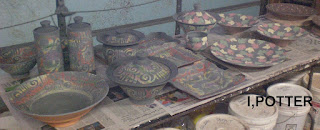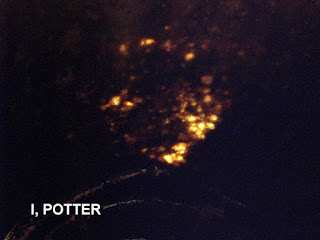Without sounding like I am not totally grounded in some
sense of reality, I am a strong believer
in fate and that as a collector, if you are meant to own a piece, at some
point, you will. It is also important to remember, that time and patience also
play a huge role in collecting and it has to be approached as a long term thing
as opposed to , say, the immediacy of collecting PEZ at the local 7/11. What
brings this up is a story, about 20 years in the making in which the maxim,
"patience is a virtue" is surely put to the test.
Back in the early 1990's on one of our trips to Japan, we
had made arrangements to visit with Shigaraki /Iga potter, Furutani Michio. By
luck, he had just opened a kiln and in his yard were blue tarps and boards,
covered with pots of every shape, size and variety, all fresh out of his kiln
and many with dango (cookies) still attached that separate pots during the
intense fire. We had gone to visit with Furutani-san with the express interest in
acquiring a slab style vase and we were given the pick of his new work. As we
picked the piece we wanted and looked about at all the treasures, I was immediately
taken by a board full of pots, all hidden away near the shed. As I survey the
pots, a chawan, upside down and with wads still attached to the foot caught my
eye. That was the bowl for me! Well, it turns out, that wasn't the bowl for me,
it had already been picked out by a gallery manager for an upcoming exhibit and
he couldn't sell it. Out of respect, I did not push or inquire further, just
resigned myself to having had the fortune to see and handle so many wonderful
pots. Months later, in the mail came the exhibit catalogue with the chawan in
it as a reminder of the serene and animated Shigaraki pot.
Flash forward 20 years and here is where the serendipity
comes in. As I was tooling around a number of the usual websites, there it was,
available for sale and at a very good price. I ordered the piece and it was
shipped off and when it arrived, 20 years later, it was just as I had
remembered. The foot that first drew my attention is a classic and well
proportioned Furutani Michio foot and the firing a blend of ash and hi-iro
accentuating the form and settling on the protruding ridge that further
animates the piece. It took a long while to get the pot, but it has a new home
now and will be greatly appreciated amid a few other pots made by one of the
finest Shigaraki/Iga potters of the 20th century.
"He that can have patience can have what he
will." Benjamin Franklin (1706-1790)










